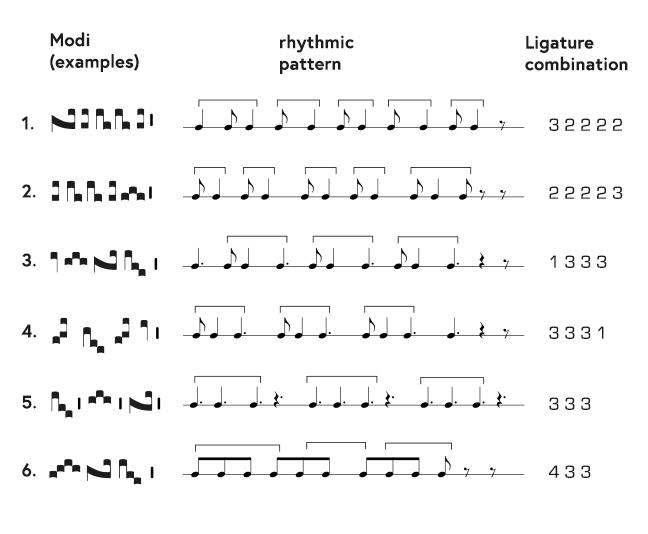'COORDINATION IN RHYTHM' – MODAL NOTATION
3.5
Rhythmic patterns – how to recognise a mode
During the period of the Notre Dame school, modal notation was based on a fixed arrangement of rhythmic patterns. These given structures constituted the starting point of this early stage of polyphonic composition.
In modal notation we distinguish six modes and their rhythmic patterns. Now you can find out how to recognise a mode from the original notation. The principle is simple: each modal pattern is tagged by the sequence of ligatures or single notes you find at the beginning of a phrase.

- The sequence of a ternary ligature followed by binary ligatures marks the first mode.
- A series of binary ligatures followed by a ternary ligature marks the second mode.
- A single note followed by ternary ligatures marks the third mode.
- A series of ternary ligatures followed by a single note marks the fourth mode.
- A series of ternary ligatures isolated by a stroke marks the fifth mode.
- The sequence of a four-note ligature followed by ternary ligatures marks the sixth mode.
The key to recognising a mode is the combination of the signs. In the last row of the table above you can see a schematic overview of the ligature combinations: 1 stands for a single note; 2 is a ligatura binaria (two-note ligature); 3 is a ligatura ternaria (three-note ligature) and 4 is a ligatura quaternaria (four-note ligature).
But what kind of logic did the medieval musicians from Notre Dame follow to encode rhythm in their compositions?
As you can observe the duration of the notes here is not inscribed in the single notational figures, thus rhythm cannot be read from the shape of the notes. In modal notation rhythm has to be deduced by scanning and counting the combination of single notes and ligatures. The sequence of signs (single notes, two-note ligatures and three-note ligatures) enables the reader to recognise the rhythmical mode. Compared to modern notation, rhythm is here codified in a more abstract manner which is based on the concept of the number (numerus).
License
Copyright: University of Basel
